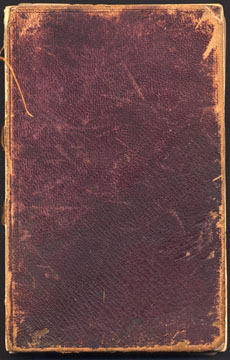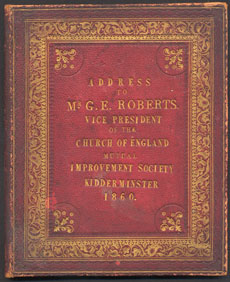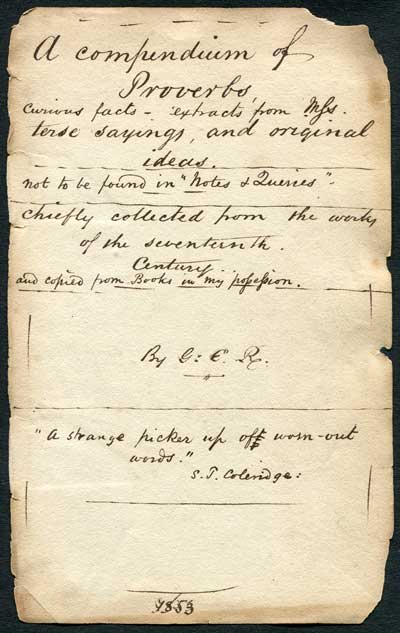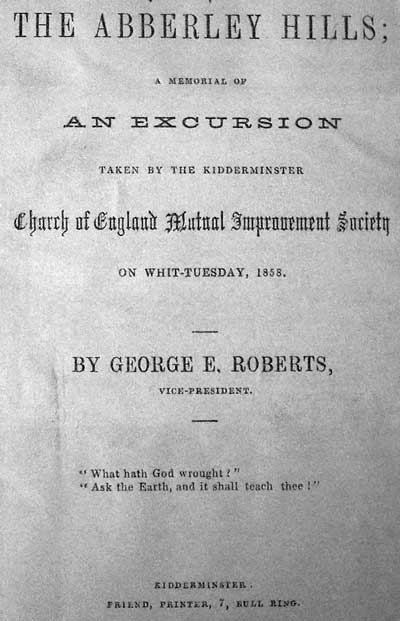
George Edward Roberts
was a member of a family which ran a draper's business in the Bull Ring for over 50 years from the early 1830s. George was born in Birmingham on the 19th May 1831, but the family had moved to Kidderminster by the time of his baptism at St Mary's Church on the 11th January 1833.
Initially the Draper's shop was run by George's father, Edward. The family lived 'above the shop' but later moved household to 'Shrubbery Cottage' in Birmingham Road where the house still lies, un-named and obscured by shrubbery, between the Holy Trinity School and St Ambrose's Presbytery. The family's presence in Kidderminster ceased when George's brother Frederick sold the business to Mr CF Holder around 1887 and moved to London.
Before entering the family business George was educated at King Charles I Grammar School situated in the Chantry of the Parish Church. There he would have come under the tutelage of the Rev. Cockin who, from 1843, re-invigorated the school after a period of relative mediocrity. Under Cockin the school moved to new premises at Woodfield in about 1847/48 (that distinctive castellated building is now the Registry Office). By then George was 16 or 17 years old and was probably working in the family shop. No doubt it was at school that he first developed his fascination for Natural History and Geology: interests that came to sustain and dominate the remainder of his relatively short life. Indeed, he later refers to "School-day associations with Habberley Valley" being "legion in number". Other contemporary scholars at the school recollect "playing cricket in Habberley Valley" and catching "butterflies at the Devil's Spadeful".
In 1853 he produced a handwritten booklet entitled 'A Walk Round Kidderminster' that demonstrates a deep knowledge of local history and legend and an in depth grasp of botanical and geological understanding. He was active in many intellectual and educational institutions around Worcestershire and beyond, and became Vice-President of the Kidderminster Branch of the Church of England Mutual Improvement Society whilst in his 20s. He did not keep his interests to himself and published two particularly important local books: 'The Valley of Habberley and Hill of Trimpley' (1857) and 'The Rocks of Worcestershire' (1860) – both of which may be found in Kidderminster Library. The first of these books may be accessed by clicking the link:
A number of George's personal writings were retained by his family and Margaret Earnshaw of Darwin, Australia (a descendent of his brother Frederick) made these available. Of particular interest is George's personal journal covering the period January 1856 to August 1857. Here, in his inimitable style, are described not only his own activities but also various happenings and developments in Kidderminster, Worcestershire and nationally. There are numerous references to various local worthies with whom he was familiar: Edward Bradley (Cuthbert Bede), Henry and Joseph Chellingworth, Henry, George and David Crane, George and Henry Friend and the Thurston family, amongst many others. One fascinating reminiscence describes the unruly parliamentary election of 1857: "March 28. Polling Day for General Election. Obliged to close from after mid-day - violence of the mob great. Attack on the Hustings at 4 o'clock. Many persons seriously hurt. Mr. Lowe badly hurt, a slight fracture of the scull. Great commotion in the town - many windows broken &c. Military sent for, who arrived at 12 o'clock p.m. Left town about 11 - things quieter." He goes on: "4th April. Town by this time quiet again - the late mischief had been long brewing -discontented workers and arbitrary masters can never long agree. No man in his sences (sic!) believe Boycott or any of his party organized the riot; whatever organisation was apparent, was due to the disbanded militia men. Such an Element of vagabondage let loose in the working life of the town was sufficient to account by its very existence for the outrages that have taken place". Throughout, the journal is interspersed with an eclectic mixture of miscellanea, quaint quotations and excerpts from books, newspapers and magazines. His descriptions of excursions reveal constant use of the relatively new railway in Kidderminster and also emphasises just how much, in those times, people relied on 'Shank's Pony'.
Eventually, George opted to pursue a professional Geological career and obtained theposition of Clerk to the Geological Society in 1860. In London he widened his horizons and published articles in several journals including: the Intellectual Review, the Journal of the Geological Society, the Geological Magazine and the Anthropological Review. In 1863 he published two papers in the same issue of the Journal of the Geological Society that also contained articles by the eminent scientists Thomas Huxley and Charles Darwin. In addition to these activities George became a member of the Anthropological Society at its inception in January 1863 and served as Hon. Secretary from June 1864 until his death.
Sadly, George's promising career ended prematurely with his sudden death at his mother's house on 21st December 1865 aged just 34. He is buried in St George's Churchyard just 200 yards from the family home. The headstone to the family grave is found easily and remains in good condition.
The 1856/57 Journal

A transcription of the 1856/57 journal of George Roberts can be downloaded, for personal use only. Click the image or the link.
A walk round Kidderminster with notes by the way Philologic and Philosophic

George Roberts also produced a hand written booklet describing a virtual walk around parts of Kidderminster and its environs, entitled:
'A walk round Kidderminster with notes by the way Philologic and Philosophic'
Not all the 'notes' have survived but a transcription of the main 'tour' with remaining notes can be downloaded by clicking the image or the link below (for personal use only).
A walk round Kidderminster transcript
1860 Leaving Address to George Roberts

When George Roberts left Kidderminster in 1860, to take up his new position as Clerk to the Geological Society in London, he was presented with an Illuminated Address by the Rev. Claughton in appreciation for his term of Office as Vice President of the local Church of England Mutual Improvement Society movement.
From this Address we can deduce that George had donated many of his Geological and Botanical specimens to 'our Museum'. It would be interesting to know which Museum that was and where, if the specimens survive, where they are now?
A transcription of the Address can be downloaded, for personal use only. click the image or the link below.
Download transcript of the address

'A Compendium of Proverbs'
In 1853 George Roberts produced an extensive handwritten eclectic collection of proverbs and curious facts taken mainly from the 17th Century.
A transcription of this notebook is available for you to visit via the link below. The collection concludes with a Riddle to which the answer is not supplied. You are invited to work out the (not too demanding) solution yourself, but we offer no prizes for a correct analysis. Click the image or the link below to:
Download transcription of 'A Compendium of Proverbs'
'The Abberley Hills'

George Roberts wrote this account of a Whitsuntide field trip by the Kidderminster branch of the Church of England Mutual Improvement Society to Woodbury and Abberley hills in 1858. Underlying the typical flowery language of Victorian times lies an interesting description of the geology of the hills (as understood then), the vista to be seen from them, and the flora and fauna on them.
A transcription of this book can be viewed by clicking on either the image or the following link:
Download a transcription of 'Abberley Hills'

'Botanical Notes'
George Roberts' wide interest in the natural sciences included botany. He kept a notebook that was in essence a personal 'Herbarium' with notes about botanical species and a number of pressed flowers some of which have survived to the present day. The notes were clearly a 'work in progress' and it seems likely that this notebook dates from histime in Kidderminster prior to his removal to London to work with the Geological Society. The image shows two consecutive pages from this work.
An illustrated transcription of the whole notebook can be downloaded as a 35MB PDF file by clicking on the image or the link below:

